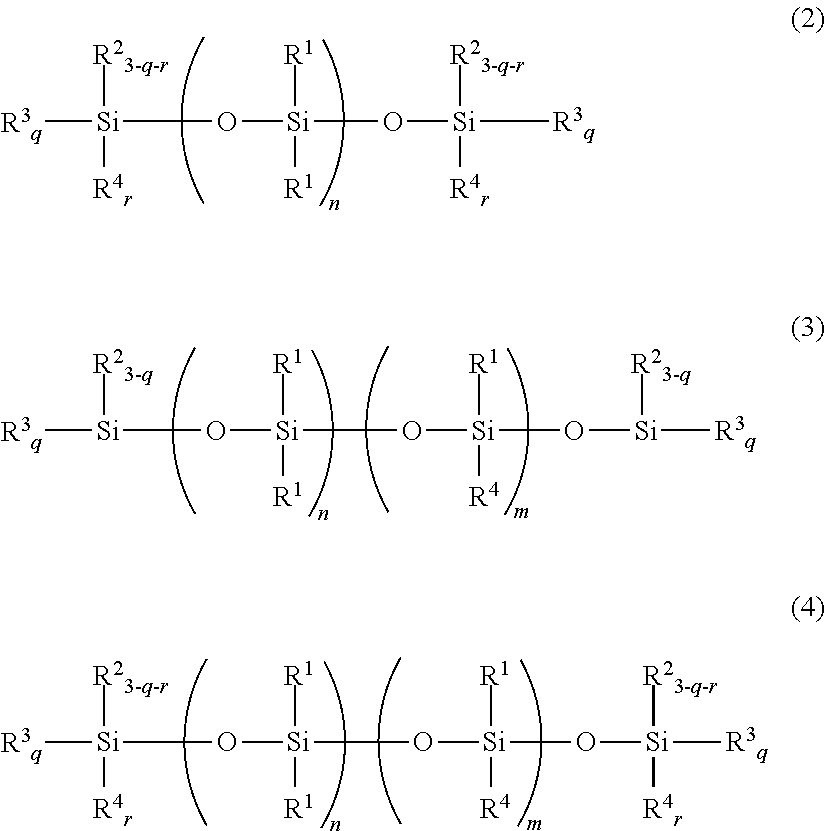Blocked polyisocyanate-containing curable silicone composition and textile treatment using the same
a technology of curable silicone and polyisocyanate, which is applied in the field of blocked polyisocyanatecontaining curable silicone composition, can solve the problems of high-temperature treatment and tend to be a loss of softness, and achieve excellent low-temperature curability, excellent durability to washing, and good softness and water absorption.
- Summary
- Abstract
- Description
- Claims
- Application Information
AI Technical Summary
Benefits of technology
Problems solved by technology
Method used
Image
Examples
synthesis example 1
[0113]A separable flask equipped with a thermometer, a stirrer, a reflux condenser and a nitrogen gas inlet was charged with 100 g of aminoalkyl group-containing organopolysiloxane of formula (A) below (molecular weight, 4,066; amine equivalent weight, 1,010 g / mol), the polyethylene glycol monobutyl monoglycidyl ether shown in formula (B) below (molecular weight, 349) in an amount of 52 g (this being the amount such that the ratio of the number of glycidyl groups on the polyethylene glycol monobutyl monoglycidyl ether to the total number of nitrogen-bonded hydrogen atoms (—NH) on the aminoalkyl group-containing organopolysiloxane becomes 1.0), and 7.4 g of isopropyl alcohol. Nitrogen gas was introduced into the system, after which the system was tightly sealed and an addition reaction was carried out for 4 hours at 80° C. Following reaction completion, removal of the low-boiling fraction was carried out for 1 hour at 80° C. and under a reduced pressure of 10 mmHg, yielding 145 g of ...
synthesis example 2
[0115]The interior of a separable flask fitted with a stirrer, a thermometer, a reflux condenser, a nitrogen blowing tube and a dropping funnel was placed under a nitrogen atmosphere, charged with 600 parts of hexamethylene diisocyanate, and the temperature within the reactor was held at 70° C. under stirring. The isocyanurate-forming catalyst tetramethylammonium caprate was added and, when the rate of conversion reached 40%, the reaction was stepped by adding phosphoric acid. The reaction mixture was filtered, following which unreacted hexamethylene diisocyanate was removed using a thin-film evaporator. The resulting polyisocyanate had a viscosity at 25° C. of 2,500 mPa·s and a number-average molecular weight of 680.
[0116]The rate of conversion for isocyanurate formation was obtained by determining the surface area of the peak at the molecular weight corresponding to the isocyanurate as a proportion of the sum of the surface area of the peak at the molecular weight corresponding to...
synthesis example 3
[0117]A reactor like that in Synthesis Example 2 was charged with 100 parts of the isocyanurate obtained in Synthesis Example 2, 13 parts of polypropylene diol, and butyl acetate as the solvent in an amount such that the final blocked polyisocyanate ingredient concentration becomes 90 wt %, and the system was held under a nitrogen atmosphere for 3 hours at 70° C. Next, 50 parts of 3,5-dimethylpyrazole was added, and the characteristic absorption of isocyanate groups in the infrared spectrum was confirmed to have vanished. The resulting blocked polyisocyanate had an average molecular weight of 1,200.
PUM
| Property | Measurement | Unit |
|---|---|---|
| viscosity | aaaaa | aaaaa |
| viscosity | aaaaa | aaaaa |
| viscosity | aaaaa | aaaaa |
Abstract
Description
Claims
Application Information
 Login to View More
Login to View More - R&D
- Intellectual Property
- Life Sciences
- Materials
- Tech Scout
- Unparalleled Data Quality
- Higher Quality Content
- 60% Fewer Hallucinations
Browse by: Latest US Patents, China's latest patents, Technical Efficacy Thesaurus, Application Domain, Technology Topic, Popular Technical Reports.
© 2025 PatSnap. All rights reserved.Legal|Privacy policy|Modern Slavery Act Transparency Statement|Sitemap|About US| Contact US: help@patsnap.com



